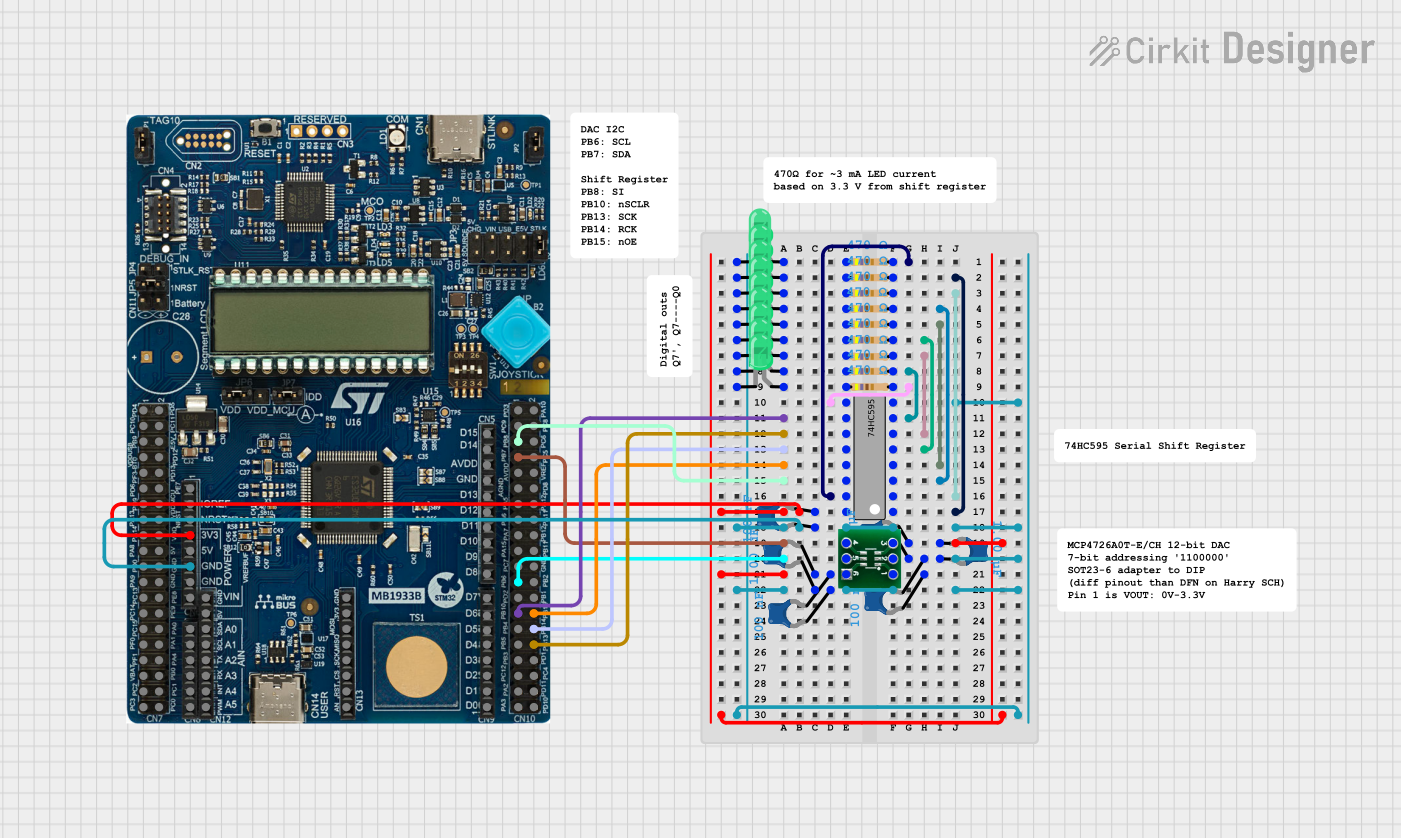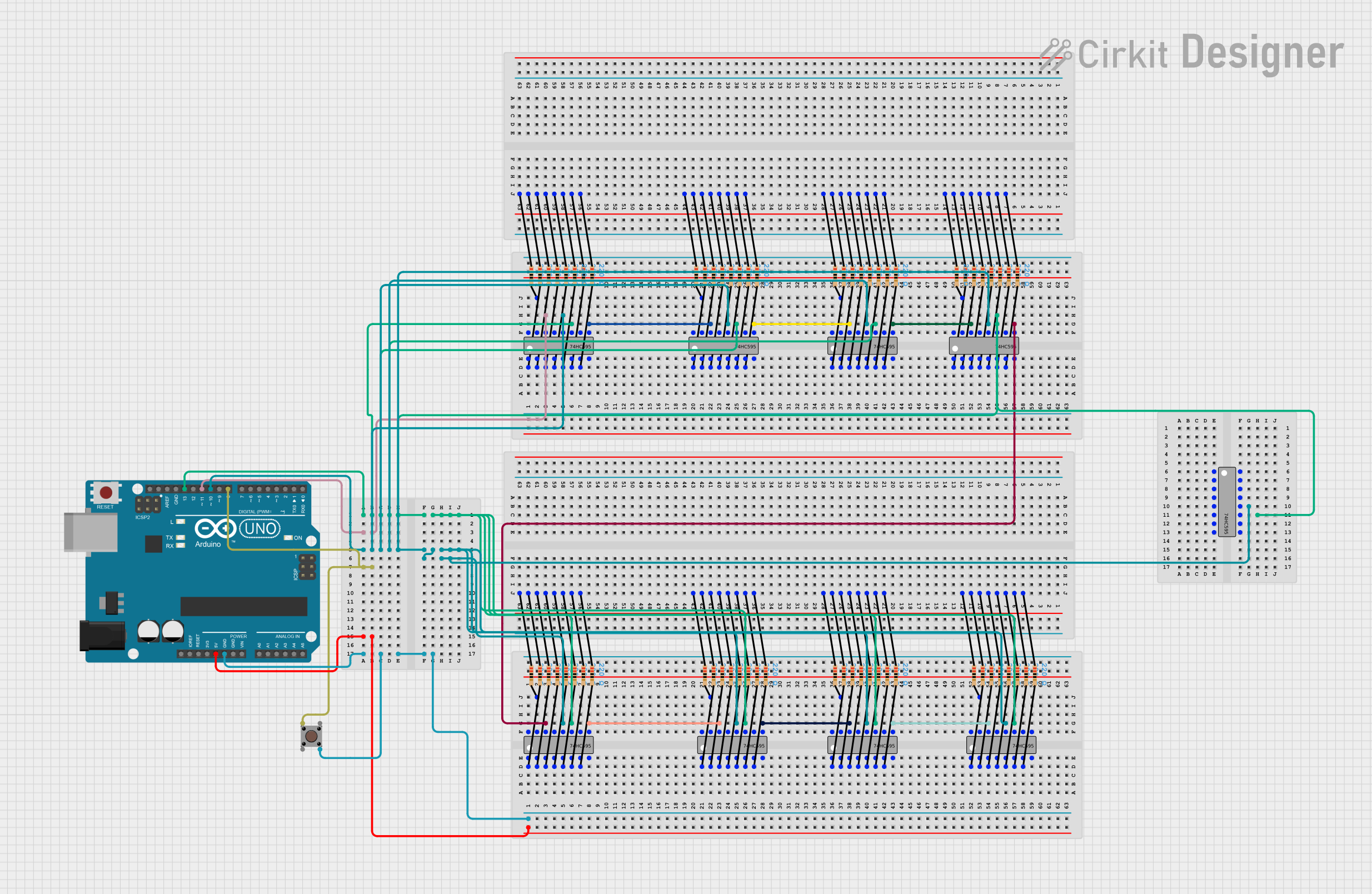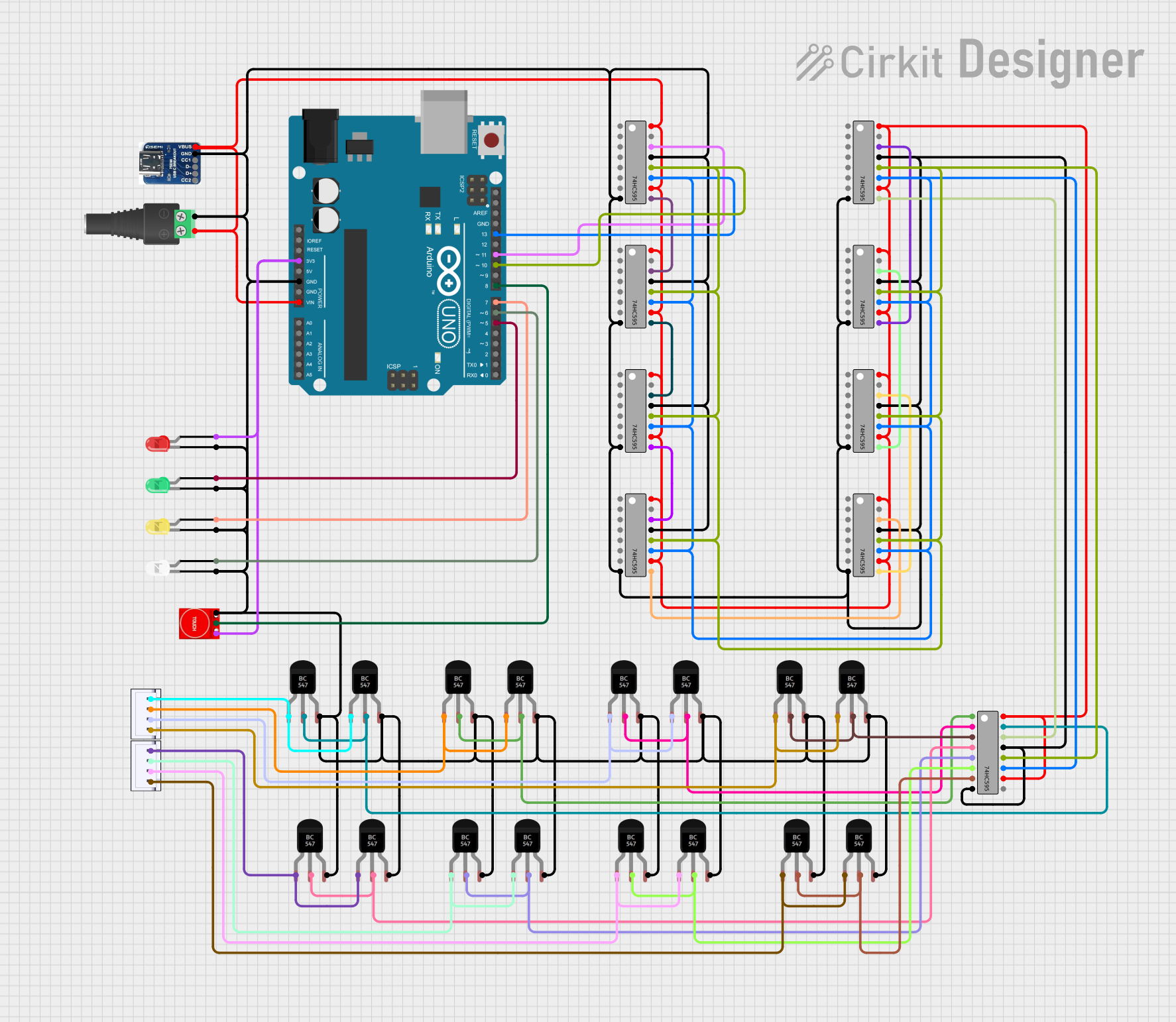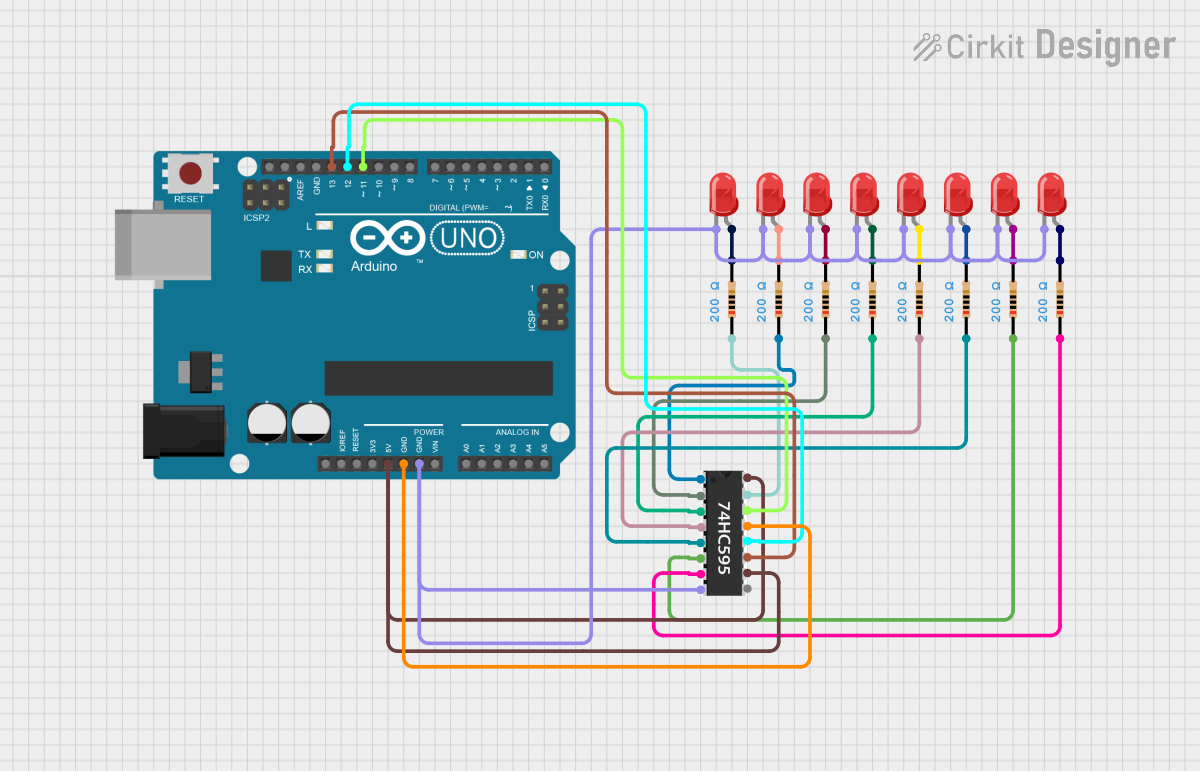
How to Use 74HC595: Examples, Pinouts, and Specs

 Design with 74HC595 in Cirkit Designer
Design with 74HC595 in Cirkit Designer74HC595 Shift Register Documentation
Introduction
The 74HC595 is an 8-bit serial-in, parallel-out shift register with an output latch. It is designed to enable serial-to-parallel data conversion, allowing microcontrollers to control multiple outputs using fewer pins. This component is widely used in applications where GPIO (General Purpose Input/Output) pin limitations are a concern, such as driving LED arrays, 7-segment displays, or controlling relays.
Manufactured by Arduino, the 74HC595 (Part ID: UNO) is a versatile and cost-effective solution for expanding the output capabilities of microcontrollers like the Arduino UNO. It supports cascading, which means multiple 74HC595 chips can be connected in series to control even more outputs.
Common Applications
- Driving LED matrices or 7-segment displays
- Controlling relays or other high-power devices
- Expanding GPIO pins for microcontrollers
- Multiplexing and demultiplexing signals
- Digital signal processing
Technical Specifications
The following table outlines the key technical details of the 74HC595 shift register:
| Parameter | Value |
|---|---|
| Supply Voltage (Vcc) | 2V to 6V |
| Input Voltage (Vin) | 0V to Vcc |
| Output Current (Iout) | ±6mA per pin |
| Maximum Clock Frequency | 25 MHz (at 4.5V) |
| Operating Temperature | -40°C to +125°C |
| Propagation Delay | 15 ns (typical at 5V) |
| Package Type | DIP-16, SOIC-16, TSSOP-16 |
Pin Configuration and Descriptions
The 74HC595 has 16 pins, as described in the table below:
| Pin Number | Pin Name | Description |
|---|---|---|
| 1 | Q1 | Parallel output pin 1 |
| 2 | Q2 | Parallel output pin 2 |
| 3 | Q3 | Parallel output pin 3 |
| 4 | Q4 | Parallel output pin 4 |
| 5 | Q5 | Parallel output pin 5 |
| 6 | Q6 | Parallel output pin 6 |
| 7 | Q7 | Parallel output pin 7 |
| 8 | GND | Ground (0V) |
| 9 | Q7' | Serial data output for cascading additional 74HC595 chips |
| 10 | MR (Reset) | Master reset (active LOW) |
| 11 | SH_CP | Shift register clock input (rising edge triggered) |
| 12 | ST_CP | Storage register clock input (latch pin) |
| 13 | OE (Enable) | Output enable (active LOW) |
| 14 | DS | Serial data input |
| 15 | Q0 | Parallel output pin 0 |
| 16 | Vcc | Positive supply voltage |
Usage Instructions
How to Use the 74HC595 in a Circuit
- Power the Chip: Connect the Vcc pin to a 5V power supply and the GND pin to ground.
- Connect Control Pins:
- DS (Pin 14): Connect to the microcontroller's data pin for serial input.
- SH_CP (Pin 11): Connect to the microcontroller's clock pin to shift data into the register.
- ST_CP (Pin 12): Connect to the microcontroller's latch pin to transfer data to the output pins.
- OE (Pin 13): Connect to ground to enable the outputs (active LOW).
- Connect Outputs: Use the Q0–Q7 pins to drive LEDs, relays, or other devices.
- Optional Cascading: To expand outputs, connect the Q7' (Pin 9) of the first 74HC595 to the DS (Pin 14) of the next chip.
Best Practices
- Use current-limiting resistors (e.g., 220Ω) on the output pins when driving LEDs to prevent damage.
- Keep the clock signal clean and free of noise to ensure reliable data shifting.
- Use decoupling capacitors (e.g., 0.1µF) between Vcc and GND to stabilize the power supply.
Example Arduino Code
The following example demonstrates how to use the 74HC595 with an Arduino UNO to control 8 LEDs:
// Define 74HC595 control pins
const int dataPin = 2; // DS (Pin 14) - Serial data input
const int latchPin = 3; // ST_CP (Pin 12) - Latch pin
const int clockPin = 4; // SH_CP (Pin 11) - Clock pin
void setup() {
// Set control pins as outputs
pinMode(dataPin, OUTPUT);
pinMode(latchPin, OUTPUT);
pinMode(clockPin, OUTPUT);
}
void loop() {
// Example pattern: Turn on LEDs one by one
for (int i = 0; i < 256; i++) {
digitalWrite(latchPin, LOW); // Disable latch to shift data
shiftOut(dataPin, clockPin, MSBFIRST, i); // Send data to 74HC595
digitalWrite(latchPin, HIGH); // Enable latch to update outputs
delay(500); // Wait for 500ms
}
}
Code Explanation
shiftOut(): Sends 8 bits of data to the 74HC595, one bit at a time.- Latch Control: The latch pin is toggled LOW to HIGH to transfer data from the shift register to the output pins.
- Pattern: The loop cycles through values from 0 to 255, lighting up LEDs in a binary pattern.
Troubleshooting and FAQs
Common Issues
Outputs Not Responding
- Ensure the OE (Pin 13) is connected to ground (active LOW).
- Verify the connections to the control pins (DS, SH_CP, ST_CP).
Flickering Outputs
- Check for noise on the clock signal.
- Add decoupling capacitors near the Vcc and GND pins.
Incorrect Output Pattern
- Verify the data being sent to the shift register.
- Ensure the clock and latch signals are properly synchronized.
FAQs
Can I cascade multiple 74HC595 chips?
- Yes, connect the Q7' (Pin 9) of one chip to the DS (Pin 14) of the next chip.
What is the maximum number of chips I can cascade?
- Theoretically unlimited, but practical limits depend on signal integrity and power supply.
Do I need pull-up or pull-down resistors?
- Not typically required, but you may use them for noise suppression on control lines.
Conclusion
The 74HC595 shift register is a powerful and flexible component for expanding the output capabilities of microcontrollers like the Arduino UNO. Its ability to perform serial-to-parallel data conversion, combined with cascading support, makes it ideal for a wide range of applications. By following the guidelines and best practices outlined in this documentation, users can effectively integrate the 74HC595 into their projects.
Explore Projects Built with 74HC595

 Open Project in Cirkit Designer
Open Project in Cirkit Designer
 Open Project in Cirkit Designer
Open Project in Cirkit Designer
 Open Project in Cirkit Designer
Open Project in Cirkit Designer
 Open Project in Cirkit Designer
Open Project in Cirkit DesignerExplore Projects Built with 74HC595

 Open Project in Cirkit Designer
Open Project in Cirkit Designer
 Open Project in Cirkit Designer
Open Project in Cirkit Designer
 Open Project in Cirkit Designer
Open Project in Cirkit Designer
 Open Project in Cirkit Designer
Open Project in Cirkit Designer